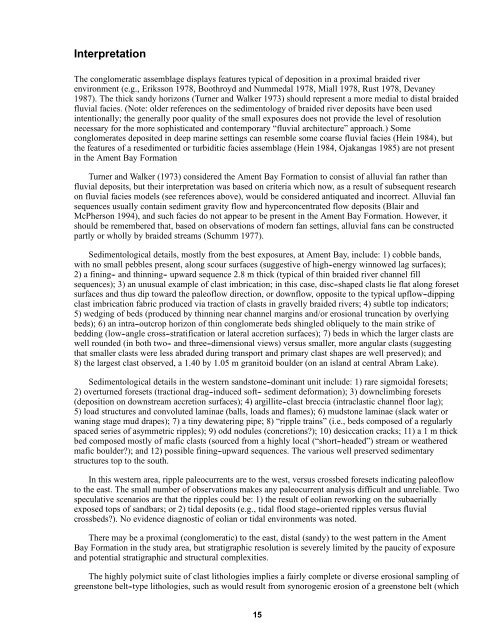Regional Geology, Sioux Lookout Orogenic Belt - Geology Ontario
Regional Geology, Sioux Lookout Orogenic Belt - Geology Ontario
Regional Geology, Sioux Lookout Orogenic Belt - Geology Ontario
Create successful ePaper yourself
Turn your PDF publications into a flip-book with our unique Google optimized e-Paper software.
Interpretation<br />
The conglomeratic assemblage displays features typical of deposition in a proximal braided river<br />
environment (e.g., Eriksson 1978, Boothroyd and Nummedal 1978, Miall 1978, Rust 1978, Devaney<br />
1987). The thick sandy horizons (Turner and Walker 1973) should represent a more medial to distal braided<br />
fluvial facies. (Note: older references on the sedimentology of braided river deposits have been used<br />
intentionally; the generally poor quality of the small exposures does not provide the level of resolution<br />
necessary for the more sophisticated and contemporary “fluvial architecture” approach.) Some<br />
conglomerates deposited in deep marine settings can resemble some coarse fluvial facies (Hein 1984), but<br />
the features of a resedimented or turbiditic facies assemblage (Hein 1984, Ojakangas 1985) are not present<br />
in the Ament Bay Formation<br />
Turner and Walker (1973) considered the Ament Bay Formation to consist of alluvial fan rather than<br />
fluvial deposits, but their interpretation was based on criteria which now, as a result of subsequent research<br />
on fluvial facies models (see references above), would be considered antiquated and incorrect. Alluvial fan<br />
sequences usually contain sediment gravity flow and hyperconcentrated flow deposits (Blair and<br />
McPherson 1994), and such facies do not appear to be present in the Ament Bay Formation. However, it<br />
should be remembered that, based on observations of modern fan settings, alluvial fans can be constructed<br />
partly or wholly by braided streams (Schumm 1977).<br />
Sedimentological details, mostly from the best exposures, at Ament Bay, include: 1) cobble bands,<br />
with no small pebbles present, along scour surfaces (suggestive of high--energy winnowed lag surfaces);<br />
2) a fining-- and thinning-- upward sequence 2.8 m thick (typical of thin braided river channel fill<br />
sequences); 3) an unusual example of clast imbrication; in this case, disc--shaped clasts lie flat along foreset<br />
surfaces and thus dip toward the paleoflow direction, or downflow, opposite to the typical upflow--dipping<br />
clast imbrication fabric produced via traction of clasts in gravelly braided rivers; 4) subtle top indicators;<br />
5) wedging of beds (produced by thinning near channel margins and/or erosional truncation by overlying<br />
beds); 6) an intra--outcrop horizon of thin conglomerate beds shingled obliquely to the main strike of<br />
bedding (low--angle cross--stratification or lateral accretion surfaces); 7) beds in which the larger clasts are<br />
well rounded (in both two-- and three--dimensional views) versus smaller, more angular clasts (suggesting<br />
that smaller clasts were less abraded during transport and primary clast shapes are well preserved); and<br />
8) the largest clast observed, a 1.40 by 1.05 m granitoid boulder (on an island at central Abram Lake).<br />
Sedimentological details in the western sandstone--dominant unit include: 1) rare sigmoidal foresets;<br />
2) overturned foresets (tractional drag--induced soft-- sediment deformation); 3) downclimbing foresets<br />
(deposition on downstream accretion surfaces); 4) argillite--clast breccia (intraclastic channel floor lag);<br />
5) load structures and convoluted laminae (balls, loads and flames); 6) mudstone laminae (slack water or<br />
waning stage mud drapes); 7) a tiny dewatering pipe; 8) “ripple trains” (i.e., beds composed of a regularly<br />
spaced series of asymmetric ripples); 9) odd nodules (concretions?); 10) desiccation cracks; 11) a 1 m thick<br />
bed composed mostly of mafic clasts (sourced from a highly local (“short--headed”) stream or weathered<br />
mafic boulder?); and 12) possible fining--upward sequences. The various well preserved sedimentary<br />
structures top to the south.<br />
In this western area, ripple paleocurrents are to the west, versus crossbed foresets indicating paleoflow<br />
to the east. The small number of observations makes any paleocurrent analysis difficult and unreliable. Two<br />
speculative scenarios are that the ripples could be: 1) the result of eolian reworking on the subaerially<br />
exposed tops of sandbars; or 2) tidal deposits (e.g., tidal flood stage--oriented ripples versus fluvial<br />
crossbeds?). No evidence diagnostic of eolian or tidal environments was noted.<br />
There may be a proximal (conglomeratic) to the east, distal (sandy) to the west pattern in the Ament<br />
Bay Formation in the study area, but stratigraphic resolution is severely limited by the paucity of exposure<br />
and potential stratigraphic and structural complexities.<br />
The highly polymict suite of clast lithologies implies a fairly complete or diverse erosional sampling of<br />
greenstone belt--type lithologies, such as would result from synorogenic erosion of a greenstone belt (which<br />
15

















